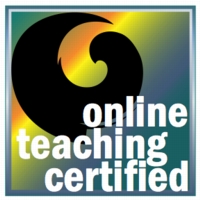Lately it’s been kind of eerie in the world of open online classes, at least those taught by folks whose work I respect the most.
 This year, our Program for Online Teaching leadership for the POT Certificate Class was down to three overworked facilitators, plus our wonderful moderators and those who let us use their videos. The class was definitely a Small Open Online Class, and since it had assigned readings and a schedule, and since MOOCs have become mega-commercial horrors, I no longer call it a MOOC of any sort anyway. For such a small group (60 registered originally), the community was fabulous, both supportive and knowledgeable. A little over a dozen learners completed and earned a badge for spring semester, and/or a certificate for the entire 2013-14 year.
This year, our Program for Online Teaching leadership for the POT Certificate Class was down to three overworked facilitators, plus our wonderful moderators and those who let us use their videos. The class was definitely a Small Open Online Class, and since it had assigned readings and a schedule, and since MOOCs have become mega-commercial horrors, I no longer call it a MOOC of any sort anyway. For such a small group (60 registered originally), the community was fabulous, both supportive and knowledgeable. A little over a dozen learners completed and earned a badge for spring semester, and/or a certificate for the entire 2013-14 year.
The format of the class was different from the previous year (2012-13), where I had struggled (as a non-programmer) with FeedWordpress to bring in everyone’s feeds. Instead we used a Google Site. We asked everyone to post a link to their blog post at the Site, and engage in discussion at the Site instead of in the blog comments. I was able to bring in blog feeds easily using Gadgets.
I just took a peek at Alec Couros’ DCMOOC, and noticed participants in their Google Plus Community posting links to their weekly blog post. Aha!
Now, when it came to our POT Cert Class this year, there were some issues. I wasn’t delighted with the non-nested discussions in Google Sites, and we discovered that three people couldn’t really run the class effectively, even with moderators, when all three facilitators work full-time plus. But the need, at our college and elsewhere, for pedagogically-based learning about how to teach online is still there. So we decided to create a self-guided Learning Pathway instead.
Then I discovered there was already a Google Plus Community, to which I was invited, called Learning Pathways. Aha!

Anyway, I started creating the new Pedagogy First! Learning Pathway (work in progress is here), and my colleague Laura Paciorek has been helping. The idea is that the pathway is essentially comprised of curated content and assignments for a portfolio, and that any individual or group could participate and use the site for a “class” or individual study. Then for community, we plan to use our own POT Google Plus Community (mostly because some folks don’t like Facebook, where we also have a POT group).
So then I find that Jim Groom has created a self-directed class for ds106. Based on the successful Headless ds106, it is called the Open ds106 Course. Aha!
The synchronicity is striking, or at least it strikes me. And the trends for these classes, and many more, defy a number of assumptions I made when all this cMOOCishness and openness stuff started. I mean waaaay back in 2005 or so (which is also when I started the Program for Online Teaching).
(NB: I am deliberately ignoring xMOOCs, those based in commercial or university-commercial collaborations. My focus here is on what I’ve called Task-Based MOOCs.)
I am surprised to see that when it comes to task-based open online classes:
1. We haven’t ditched the “course”.
While we all acknowledge the importance of connections and helping people be nodes in a network, what this looks like in practice isn’t that different from any other sort of dedicated community that uses online space to interact. And we all continue to create some sort of teacher-designed content, even if it’s just a pathway through assignments or a schedule or a set of expectations.
2. We don’t have a wide variety of platforms from which to choose.
I believe that Alec Couros began designing open courses in wikis, but now is using WordPress. Jim Groom’s ds106 is WordPress-based also. So was OCTEL. Hybrid Pedagogy’s MOOCMOOC used Instructure Canvas, but for most of the open classes and cMOOCs, WordPress seems preferred. I’ve moved back to it myself with the Learning Pathway, although the discussion will be in G+. I recall when the choices were more diverse, and even a time when Alec and I were searching for an open discussion program that featured nested posts, as in Moodle and Ning.
3. The personality/persona of the instructor continues to be a factor in the success of an open class.
Jim Groom, David Wiley, Dave Cormier, George Siemens, Stephen Downes, Alec Couros, Jesse Stommel — all have distinct, interesting personalities and teaching styles. Participants, even while creating communities and connections, are guided not only by the design of the class but by the instructor’s presence. Without a teacher who inspires, an open online class is just a website.
Given these similarities, do we now have models for independent open online classes? And when it comes to designing an open online class, have we hit our stride or are we in a rut?
FYI the open ds106 course
http://cogdogblog.com/2014/01/14/the-open-ds106-experience/
I love it when you post code. 😉 This is great. I’m also enjoying http://ds106.us/teaching-ds106/. I need to put you on this list of teachers I so admire, too.